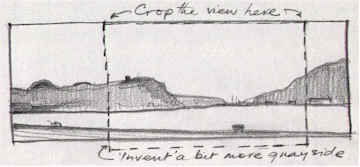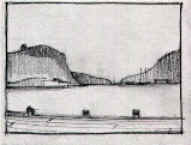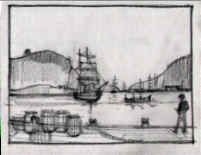|
The Newfoundland Project: First Page |
To reconstruct a view of the Brigantine Lurline arriving in her destination port of St.John's in the mid 1870's |
|
|
|
||
home introduction equipment and colours
preparation, drawing and composition demonstration useful links
The Old Luggers online Academy of Marine Painting
|
The Newfoundland Project: First Page |
To reconstruct a view of the Brigantine Lurline arriving in her destination port of St.John's in the mid 1870's |
|
|
|
||
As far as possible this will be a 'real time' exercise ie. things will appear more or less when they happen - as against 'here's one I fixed earlier'
Mistakes and problems should show up when they happen and will be there to be worked through. All contributions will be welcome - suggestions and observations to

Scroll down to continue
| So what's involved? | |||
|
|||
| Day One: The Man and His Ship | |||
|
As well as providing authentic detail about Lurline, browsing old pictures and documents can help set the mood for our picture. We see a 19th century man pitting his wooden ship against North Atlantic gales in winter and with him get a hint of the relief on passing the narrows into the shelter of St.John's Bay. Perhaps a bit of this will find its way into the finished work.
|
|||
|
Orlando Partridge Master Mariner 1844-1928 |
|
Born at South Pool, Salcombe Estuary, Devon. He was at sea for 54 years mainly trading on the North Atlantic for W.W.Steer. He skippered both 'Lurline' and 'Elmina' carrying principally fruit to the Canadian East Coast. | |
|
|
A cased plank-on-frame model of 'Lurline' made by Captain Partridge's grandson | ||
|
|
Left: 'Lurline' in a bottle
Right: A sailor-drawn portrait of 'Lurline'. The rigging is drawn with pencil and ruler while trailing leeches are slit to create low relief. |
|
|
|
Detail from 'A September Afternoon in Salcombe Harbour' by Austin Hill (click for 'brushstrokes' view) Birthplace of Captain Orlando Partridge and where 'Lurline' was built. Day two: Choosing a View |
|||
| A maritime contact on the net has sent us copious pilotage information about St.John's and enough views of the bay to spoil us for choice! The one below seems to offer the best scope to show a ship making port. It will also provide a powerful impression of depth in our picture thanks to the converging and receding flanks.
This shot looks east towards the
entrance narrows. Our picture won't be this shape so it'll be a case of
cropping left and right to make a more conventional view of it.
But it must include the high feature on the left - Signal Hill -
and enough of the right margin to show the jetties and breakwater on that side of the channel.The foreground quayside could also be
useful but will clearly need setting in an earlier epoch.Here's a close-up of Signal Hill
|
|||
| Day three: Making a start | |||
| We'll make
a few rough sketches to develop a composition.
. |
|||
 |
This makes Signal Hill the main feature on the left. The panoramic view is probably a wide angle shot in which case the feature appears smaller and further away than it is. The view of a schooner against the feature may be in telephoto however, in which case the hill looks higher than it should relative to the boat. This is all about justifying a bit of artist's licence when I make the hill a bit higher to act as backdrop to Lurline's canvas! We'll also deepen the bit of quayside to make room for some foreground interest. | ||
 |
Left: the cropped view as empty stage. Right: with some objects placed in it very provisionally - including undefined clutter on the quayside. |
 |
To be continued and concluded on Newfoundland Project Page Two now in preparation. This will show the finished painting arrived at through all its stages, probably preceded by some more trial sketches.
Go to Newfoundland Project Page Two
Click the Lurline Icon for The Old Luggers Home Page
home introduction equipment and colours
preparation, drawing and composition demonstration useful links